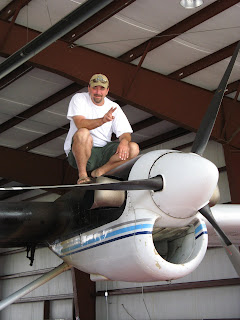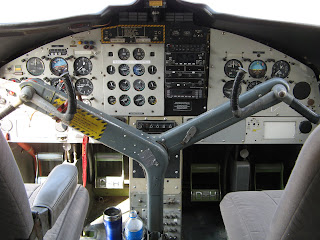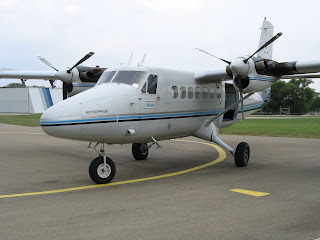Subscribe to Airspeed through iTunes or your favorits other podcatcher. Or listen online right here by clicking: http://media.libsyn.com/media/airspeed/AirspeedOtter1.mp3. It’s all free!
Thanks, everyone, for bearing with me through the end of the year! It should come as a surprise to no one who’s been with Airspeed through the last couple of years that November and December is usually awful for me because, as a technology and aviation lawyer, I have lots of clients who want to get deals done before year end. And that translates to some really busy days in the closing months of the year.
I should also say that it’s partly on me because I did a lot of training between July and October. Between July 14 and October 23, I did seven training flights for 12.8 hours and 21 instrument approaches, plus about 12 hours of simulator time with 60+ approaches, all in preparation for the instrument checkride. I know that it doesn’t sound like a lot, but, with everything that goes into getting to the airport, preflight, postflight, briefings, and getting my head back to my desk, that translates to about a week off work by the time you count the three rescheduled times for the checkride, the paperwork, and lots of other stuff.
By the time you’re out of the office that much, you need to make up some of that time later in the year. And that’s what I’ve been doing since October.
Thanks for the wonderful response to Fingers in the Airport Fence Entwined! Thanks for all the great e-mails and blog comments and an especially big thank-you to all of you who have bought the book. I should mention that, shortly after the last episode, I posted a version of Fingers in the Airport Fence Entwined that has only the music and the reading of the piece. I know that there was a lot of commentary surrounding the pierce in the episode itself and figured that some might want just the piece. Check out the website at www.airspeedonline.com and look for the blog entry right after Fingers episode. There’s a link to that special MP3 file there.
Anyway, I’ve been telling you that I have good stuff in the can and it’s going to be coming out of the can and into your ears starting now.
I first became acquainted with Dave Schwartz in 2006 after he wrote in to comment on my ride with the US Army Golden Knights. Dave is a talented pilot and skydiver and is one of the co-founders and hosts of Skydive Radio, the first all-skydiving podcast. Incidentally, Skydive Radio just hit its 100th episode. I invited Dave onto the show and he was a great guest – Helping us to understand skydiving as a sport and giving general aviation pilots some pointers about, among other things, how best to share airspace with skydiving operations. (Listen at http://media.libsyn.com/media/airspeed/AirspeedSkydive.mp3.)
Dave has since been a great resource and he even helped with some of the background research on the Twin Otter that came in very handy for the episode on icing with the NASA Glenn team. (Listen at http://media.libsyn.com/media/airspeed/AirspeedIcingGlenn1.mp3.)
Not long ago, Dave invited me out to Skydive Chicago to sit right seat for a few jump runs in the Twin Otter. I have a few clients in the Chicago area and I need to go visit them every once in awhile, so I planned a trip in late September that included a first stop at Skydive Chicago, a little more than an hour west of Chicago proper in Ottawa, Illinois.
I arrived a little after 8:00 a.m. and met Dave. We loaded up into an all-terrain vehicle and toured the grounds. The place is pretty cool. For one thing, it’s designed from the ground up to efficiently function as a skydiving training and recreation center.
It’s a 230-acre complex. The hangar that provides 15,000 square feet of shade and shelter adjoining 22,500 square feet of classrooms, common areas with satellite feed, recreation centers with pool tables and video games, a pro shop, a video department, and deli that serves food and beverages of both the soft and adult varieties. At night, you can enjoy movies or a club-type party in a two-level auditorium theatre, featuring a 30,000-watt sound and projection system.
Just to the East is a full hook-up campground that has a large pond that¹s surrounded by sprawling decks and highlighted by an island. On the north shore is a white sand beach that adjoins a large pavilion with showers, laundry facilities, and volleyball court. The entire complex is surrounded by acres of pastures near the banks of the Fox River. You can canoe, hike, bike, and ride horses on the property.
It has its own runway, arranged 3/21, and it’s paved, 4,522 feet long and 50 feet wide. There’s automated weather 16 nm west and 16 nm east and six navaids within 40 miles, of which the Ottawa NDB is the closest at 3.5 miles.
It’s a Monday and they’re running a special for first-time tandem jumps. As Dave and I ride around taking in the sights, the new skydiving students are in the building receiving the training that will allow them to make their first tandem skydives safely.
Then Dave and I go to preflight the aircraft. Skydive Chicago has two DeHavilland DCH-6 Otters and one Cessna 182. The aircraft we’re flying today is a DHC-6-200, serial no. 199 certificated in 1997. It’s powered by two Pratt & Whitney PT6A SER engines, which produce 750 horsepower each. It’s 51’9” long, has a wingspan of 65 feet, stands 19’6” at the tail, weighs 8,000 to 9,000 pounds empty, and has a max gross takeoff weight of 12,500 pounds. These birds will accommodate 23 people at a time. We’re going to be flying five on the first load.
Just before we go preflight, Dave gets the winds aloft. We need to be able to fly a course that will allow us to drop skydivers at an altitude and place over the Earth such that they can make it back to the drop zone, considering the prevailing wind.
It’s not like a skydiver can’t find somewhere safe to land other than the smooth area provided near the runway, but there are the small matters of trees, power lines, getting a ride back to the drop zone . . . you get the picture. Plus, if I’m off my course a little in a C-172, I just correct by the time I get to the field or to the initial approach fix. Dave, on the other hand, has to get the jump run right or he’ll be scattering actual people all over hither and yon. People who, at the very least, will not be buying him any beverages.
We complete a very comprehensive preflight inspection and then Dave gets in the tug and pulls the plane around to the loading area. I’m flying right seat today and I plug the MP3 recorder into the headset jack with a Y-adapter.
The first run lasts about 18 minutes. And that includes the 24-hour check that you’re going to hear. It seems longer. But the Otter climbs beautifully and Dave is an expert at getting the aircraft back on the ground quickly and efficiently to pick up the next load.
Dave is a regular John King. He’s constantly talking, describing what he’s doing and why. For that reason, among others, I’m pretty much running the audio for this load exactly as it was recorded. You can hear the engines and some of the voices in the back before Dave adjusts the squelch. It’s reasonably short and, although there are some slow spots, it’s worth listening in realtime.
We’re going to start the cockpit audio about a minute after engine start, once the avionics come up. Then you’ll hear the 24-hour check. It’s essentially the runup that you do for the first flight of the day.
Then there’s takeoff and climb. Dave gives me the controls for most of the climb and I fly an indicated airspeed and heading. I let it drift a little, as you’ll hear, but by and large picked up the instrumentation and flight characteristics of the airplane pretty quickly.
Make no mistake. Dave is right there at the controls the entire time and is very vigilant. He follows me on the controls for the jump run and has the controls himself for the initial part of the descent and for the landing. Yeah, I get to fly the Otter, but Dave is right there the whole time. That made it a very comfortable introduction for me.
I thought about trying some shooter pilot comments to impress upon the folks in back my Chuck-Yeagerness and hardass competence in the right seat, but it’s pretty clear that the vets trust Dave and that the first-time tandem students are a little tense and wouldn’t care if Karl Pilkington was in the right seat. So I keep my mouth shut and concentrate on assisting Dave in any way I can – scanning for traffic and being as gracious a guest as I can.
As we climb, Dave points out the approaches for Midway and O’Hare and explains the fairly narrow piece of airspace into which we have to confine our operations. I’m not sure of this, but it appears that Dave has two PTT switches on the yoke. I’m pretty sure that he has the CTAF of 122.725 on one channel and Chicago Approach on 119.0 on the other. We call up Chicago shortly after takeoff and let them know that we’re around.
We’ve set up the GPS to give us a 230 course line. We’ll fly a downwind and then come back upwind on that line with the idea being to give the jumpers the green light a little upwind of the drop zone. I’m pretty much flying a pitch attitude and vectors called out by Dave.
Yeah, that’s the view out the front window right after the jumpers exit.
Once the jumpers exit, we chop the power, bank 60 degrees left and go 30 degrees nose-down to get the aircraft down as quickly as possible and while burning as little fuel and brake pads as possible. If you get the feeling that it’s all about safety and efficiency at Skydive Chicago, you’re right on. But that doesn’t mean that the picture out the window right after the jumpers exit isn’t very different from what you see during cruise. Lots of green in the windshield. But a lot of fun, too!
Flying right seat actually comes more easily than I’m expecting it to. The only truly dumbass thing I do is look at Dave’s instruments across the cockpit even though I have a full set of instruments right in front of me. I’m just too used to flying C-172s.
Anyway, let’s go to the ramp at Skydive Chicago. Five people in the back, Dave in the left seat, me in the right seat, just after bringing up the avionics.
[Flight audio.]
Next time on Airspeed, we’ll have the second jump run of the day with Dave Schwartz at Skydive Chicago with a bit more otter flying, including single-engine flight and stall characteristics.
You can find out more information about Skydive Chicago at www.skydivechicago.com or by calling them at 800 SKY-DIVE in the Chicago area and 815-433-0000 from everywhere else.
I had a chance to watch a lot of the training that went into the first tandem jump program that was going on while I was there and, while I’m not a skydiver, I was pretty impressed by the attention that I saw the instructors paying to students both on the ground and in the aircraft. It looked very standardized and professional. If I didn’t have a shoulder that likes to dislocate when you put it in to the required position for belly-flying, I might well have been in the back of the aircraft for the third load!
You can get your first tandem for about $200 and there are programs and pricing for every level of jumper. I believe that they start up operations for the season in late March or early April.
For what it’s worth, one guy on the first load went right back up on the second load. I saw him pull out of the parking lot with a smile so big that he had to put the convertible top down so he could fit his head in the car.
Tune in next time for the second jump run with more Dave, more Otter, and more cowbell. Actually, no cowbell at all, but definitely more Dave and more Otter!





